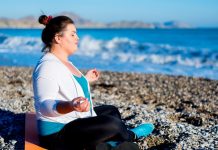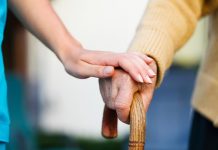The older you get, the bigger benefit from weight training you get compared to almost any other age group. Unfortunately, weight training becomes increasingly more dangerous as you get older. When done incorrectly, it can cause traumatic injuries that can reduce your activity level and keep you out of the gym for weeks or months – if not longer. But if you follow our tips, you can have a safe and productive weight training experience at any age.
Weight Machines – Should Older Adults Stay Away?
Pop quiz time. Which type of weight training is better for seniors:
- Option A – Sitting in a shoulder press machine and lifting weight by pressing bars above your head?
- Option B – Sitting on a bench and performing the exact same exercise with a dumbbell in each hand?
If you guessed option B, you’re correct – most of the time, anyway. Performing the exercise with free weights in option B helps give your muscles a more complete workout because it forces your arms to hold the weights steady in midair. On a machine, stabilizing the weight is done for you and you don’t get to exercise those muscles. In option A, those muscles will eventually grow weaker and atrophy until your ability to lift a heavy object above your head becomes impossible.
Granted, if you can’t handle free weights but still need to work your muscles, machines are better than nothing. But anything you can do to get away from those machines and towards training your stabilizer muscles with free weights is optimal for your long-term health and wellness!
The Secret Advantages of Free Weights
Free weights give your muscles and your joints something that weight machines don’t: stability and strength. Weight machines, on the other hand, can only really help you with strength. You may be able to lift a good amount of weight on a machine, but what would happen if you were to take that same weight and try to lift it above you without the support of the machine? You’d end up dropping that heavyweight right on your head!
Weight training with free weights also helps maintain joint strength. If you’re young enough, you may even be able to build up a little more strength in your tendons and cartilage before your joints start inevitably declining. The stronger your joints, the stronger and more effectively you can move your muscles. Strong joints can also help you keep your balance and avoid dangerous falls.
Safe Ways to Take on a Free Weight Workout – at Any Age

If you’re still a little nervous about using free weights, you can start by using your own body weight Instead. Try performing:
- Squat exercises – you can even place a chair under you if you’re worried about falling backwards
- Use a sturdy chair with handles to perform tricep dips
- Using very light weights or common household objects to perform shoulder press exercises
- Perform wall push-ups and gradually move down the wall until you build up enough upper body strength to perform them on the floor
Another way to work up to free weights would be to incorporate resistance bands into your workout routine. If you accidentally drop or lose your grip on a resistance band, your likelihood of injury is very small. And in some ways, resistance bands work your stability muscles more intensely than free weights because of the added tension.
Lastly, hire a personal trainer or ask a younger, stronger friend to accompany you during your workout. They can help spot you and make sure that you are performing your exercises correctly and safely. If you suddenly lose strength and can no longer hold the weight up, they can help take over and lower the weight safely to the ground so that you don’t injure yourself.
In short, neither your age nor a lack of experience should justify excluding free weights from your workout. If you get your doctor’s permission and help from someone who knows what they’re doing, there’s no reason you can’t start training with free weights. They help improve the strength of your stability muscles and also strengthen your joints. The longer you can maintain muscular stability and joint strength, the longer you can maintain independent mobility and enjoy a higher quality of life.




















































